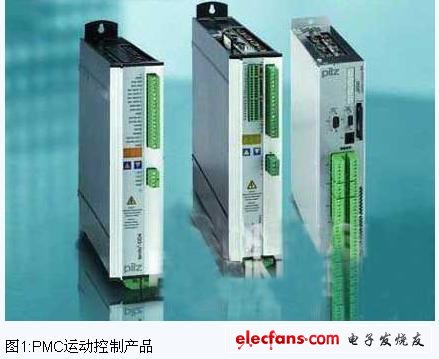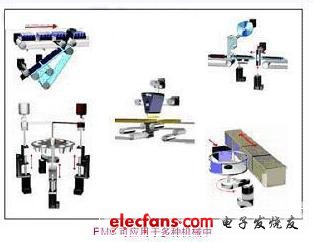Introduce the fully automated application of the motion control system in the mechanical field
For machinery manufacturers, the pressure on performance and cost is constantly increasing. Even in the technical field of actuators, in order to meet the increasing new requirements, it is absolutely necessary to develop new control structures. Today, motion control based on electronic drive systems offers a greatly increased flexibility, which is never possible with mechanical systems.
The primo device provided by Pilz is specially designed for packaging machinery, which is flexible to use and is also suitable for other similar requirements.
The primo device provides opportunities to complete the replacement of common structures and realize the expansion of the system. According to customer requirements, using PMC (Pilz Motion Control) primo control system, or connected with a main control system (such as PLC, IPC), the automation function can be fully realized. This is of particular interest to packaging machinery manufacturers.
PMC primo control system is a high-performance product series that can meet various requirements and realize fully automated functions, including the completion of various complex motion sequences. It issues instructions according to their respective requirements and selects the appropriate solution. The PMC primo16 + control system based on the controller, with separate power components, is suitable for multi-axis control, the application is very flexible, but requires a larger space.
The PMC primo transmission control system has an integral power element, which can control up to 9 transmission devices.

Open complete system for small and medium control axes
The control system with integral drive is specially designed to be suitable for a small or medium number of spindle control. In the independent mode local area network, it can further operate and control less than 8 transmission devices. In the case of adopting this structure, the transmission device equipped with the PMC primo control system has the function of a central controller.
The system has all the functions required for full automation. It has a traditional I / O input / output expansion interface and an Ethernet service interface that facilitates effective programming and long-distance maintenance. It also includes a compact flash card socket. It can communicate through CAN, Modbus or PROFIBUS, etc. This function makes the whole system in a very open position.
Due to the use of 9-axis synchronous linkage action for the operation of 8 electronic cams, the integrated soft PLC can scan 1000 instructions in the form of IL coding, and the scanning time is less than 50 microseconds. This integrated hardware design is suitable for high-speed operation and simple operation. In addition to using the battery's RAM buffer as the remaining data storage, it also provides users with a 2 Mbyte flash memory. This means that all data related to the project can be stored in the system.
This device has a new functional feature, that is, it can perform multi-dimensional motion control according to the DIN 66025 standard (a special program designed for CNC machine tools). For example, in the course of getting started, it can implement simple standardized programming. Motion control can be programmed through text or images on the soft PLC programming interface. The algorithm for optimizing the aging has nothing to do with whether the axis operation uses interpolation or whether the existing cam disc function is used. The short scan time of the soft PLC can always be kept constant.
Network functions complete a large number of shaft drive systems
In the independent mode, the PMC primo 16+ system based on the controller can be used as the central controller for up to 16 axes. The performance data is consistent with the performance data related to the transmission, because its internal design is consistent. This means that the application will be able to run on both systems without any modification.
The difference lies in the expandable fieldbus options and the network function that the system accepts a large number of spindles. If several PMC primo 16+ system devices are used, it is possible to implement a decentralized motion control unit that can control almost unlimited spindles. One of the special benefits is that users can achieve high dynamic clock speeds to achieve the goal of high accuracy. The conceptual design of the system allows up to 700 control axes. In the automation solution adopted in practice, the number of control axes has reached 53. If you need to automate more than one machine, such as a complete set of production processes, the above-mentioned challenges can fully show its own value. In addition to this, it is necessary to adopt corresponding transportation and transmission technology to control the feed and output transmission devices.
Therefore, as long as a product is used, the flexibility and performance of the entire system can be improved. This can only be achieved through a distributed transmission technology with a high-end motion control system and an integrated PLC.
Fully automated from one interface
The centralized Ethernet interface makes it possible to access the entire system, so it is also conducive to the programming and diagnosis of all connected axes. Regardless of the situation of decentralized design, from the user's point of view, the entire system represents that it exists as a centralized system because the distinction of axes occurs automatically in the background.
The most important feature is that all components and data are contained in a single user engineering project, and are realized in Pilz's new generation of drive integrated motion control system.
In practical applications, the setting of the transmission device and the generation of cams play a very important role, but first of all depends on the mutual relationship of the linkage shafts. This is the case in almost all packaging machinery. These important tools of the user are now integrated into the programming interface. Because of its simple intuition and easy operation, there is no redundant interface, design engineers can save a lot of development time and cost. As compared with programming, its various parameters can make the entire system easier to use and reduce the amount of work required to create a new application. When the packaging machinery is updated and upgraded, these advantages can indeed be reflected naturally.
The predefined function blocks stored in the database form the basis of this simple process. Its central function is to establish a connection with public programs and store the data and parameters generated there. Function blocks can be used within the scope of the project as you like, for example, the drive parameters can be downloaded every time you start repeatedly, or in another alternative, only from the service menu. When the data is transferred to the user project, a new function block can be generated, which is a modified version of the original function block of the database. In this way, each drive or cam is designated as its own separate data record. To the driving parameters, this sounds like a matter of course, but for the generation of a cam, this has a particularly important meaning.

"Cam Generator" provides support for axis verification
In an effective program, the user can define whether the cam should be flexible, and if so, which part should be clarified so that the transmission device can be adjusted according to the changes in the production process through the parameters. Once the active program is closed, the cam parameters are stored in the function block, where the variable parts, such as rounded corners, are generated as input values, and these values ​​can then be re-established within the program cycle through the fieldbus or operator terminal Set and modify.
This program provides users with an opportunity to observe cam images, and allows them to modify these images on the machine at any time. "Cam generator" can help users to select acceleration value and braking value, so as to ensure that the transmission mechanism does not shake during movement. This can greatly reduce the time required for commissioning.
In addition to being simple and clear, this function of storing all machine data within the scope of the project has also brought other positive effects. The PMC primo device is equipped with a large internal flash memory, which allows all data to be uploaded to the programming interface at any time. In this way, the current project can be stored in the local device, and if possible, it can be stored on a small and exquisite flash memory. When service is needed, this item can be copied to the PC for service, so that it can immediately start an effective diagnostic device.
If the device needs to be exchanged, a removable data storage can be used, which has the advantage of "plug and play". In addition, because it is simple and easy to use, as long as the hardware is started with a plug-in card, all data can be automatically stored in the device again.
Many users want to achieve full automation from one interface; thanks to the PMC primo controller series products and the current soft PLC devices, this hope has finally become a reality. It is used in combination with a large range of test motion control function blocks and a soft PLC interface. After expansion, it also includes "cam" and "drive setting" functions, all of which provide a way for machine manufacturers and end users. Tools that can be used to execute complex applications independently and quickly.
use AC to DC,DC to AC structure, stabilize not only voltage but also frequency.
AC Power Source,Voltage Stabilizer,AC Voltage Stabilizer,Voltage And Frequency Stabilizer
Jinan Xinyuhua Energy Technology Co.,Ltd , https://www.xyhenergy.com